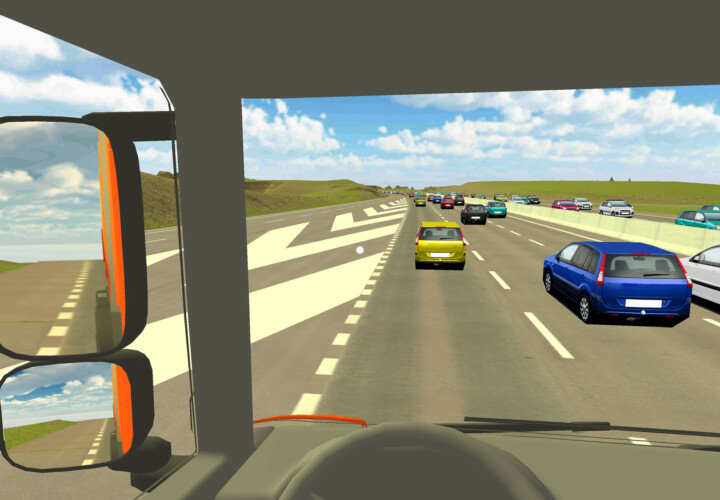Highways England is the Government agency responsible for managing and maintaining the UK’s Strategic Road Network and for the safety of road users. In a campaign aimed at reducing the number of incidents involving commercial vehicles on the UK’s roads, the agency is engaging more closely with truck drivers and operators as part of its Commercial Vehicle Incident Prevention programme.
It’s a mix of targeted advice and the use of digital enforcement technology to help identify and remove unsafe vehicles and drivers from the road network.
Virtual reality
Collisions involving lorries on the road network most commonly occur when trucks change lanes or attempt to overtake, says Highways England, with lack of awareness of exactly where a truck’s blind spots are a major contributory factory. To combat this, it has developed a virtual reality app that provides a realistic environment where drivers can experience the impact of not using their mirrors to check blind spots.
The VR solution comprises a smartphone app linked by Bluetooth to a pair of cardboard goggles. The app includes five road safety scenarios – mirror adjustment, identifying vehicles in blind spots, joining a motorway from a slip road, overtaking and tailgating.
Although developed for commercial vehicle drivers, Highways England says the app could also benefit private motorists by giving them a sense of what commercial vehicle drivers experience every day.
Smart motorway training As more of the UK motorway network becomes “smart”, Highways England is keen that drivers understand how to use the network and avoid confusion about which parts of the road they can use and when. “Commercial vehicle drivers are among the most frequent users of smart motorways so we want to ensure we are providing as much support as we can to ensure those journeys are as safe as possible,” said Wayne Carey, Senior Partnership Manager at Highways England.
The agency wants to encourage HGV operators to embrace safety training for driving on smart motorways and has teamed up with the FTA to produce a one-day training module, which is approved for use on the Driver CPC course programme.
More information is available by emailing: SPTC_Driver_Education_Course@highwaysengland.co.uk
Avoiding tyre blow-outs
More than 30 people were killed or seriously injured in motorway accidents in 2016 due to illegal or faulty tyres, says Highways England. Research by the agency and Bridgestone has concluded that almost 75% of tyre blow-outs on motorways could be attributed to poor inflation or debris penetration issues.
Highways England staff in the West Midlands provided 1,035 pieces of tyre debris from motorways to Bridgestone engineers. Analysis showed that 56% of tyres failed due to road/yard debris penetration, 18% failed due to poor inflation and 8% failed due to poor vehicle maintenance.
A drive-over tyre pressure monitoring project at Keele services powered by tyre management tech company WheelRight, on the M6 revealed that of 100,000 tyres checked, 1 in 12 was severely under-inflated and posed a potential blow-out risk. Highways England is now investigating partnerships to install the technology at strategic points on the road network.
“England’s motorways are the safest in the world but we’re determined to reduce the number of people killed and seriously injured on them. This important research confirms our view that road users must play a bigger role and get into the habit of checking tyre pressures and tread depths and looking out for nails and other debris stuck in tyres before setting out on journeys. These simple checks could save lives,” says Richard Leonard, Highways England’s head of road safety.
Smarter enforcement
1. Operation tramline
In an attempt to gain evidence of dangerous behaviour such as texting, reading and other unsafe activity in vehicles, police are using three HGV tractor units on the UK road network, funded by Highways England. The high position in the track cab allows police to capture video.
2. Digital intelligence sharing
Highways England Traffic Officer Service is sharing intelligence about dangerous or poorly maintained commercial vehicles, seen by traffic officers on their patrols, with DVSA.
A project in the North East and West Midlands successfully provided 750 pieces of intelligence to DVSA on unsafe commercial vehicles and is now being extended nationwide. Officers use a simple proforma app on their tablets, with data passed electronically to DVSA’s intelligence team for assessment and further action where appropriate. The single biggest category recorded has been vehicles taking tachograph breaks on the hard shoulder.
3. Driver fatigue
Highways England recognises that driver fatigue can be responsible for collisions, so is providing technology to support the police in conducting drivers’ hours’ checks. Since January 2017 the participating police forces have conducted over 12,000 checks which have identified more than 13,000 individual offences, with over 1,000 vehicles prohibited from continuing their journey.




